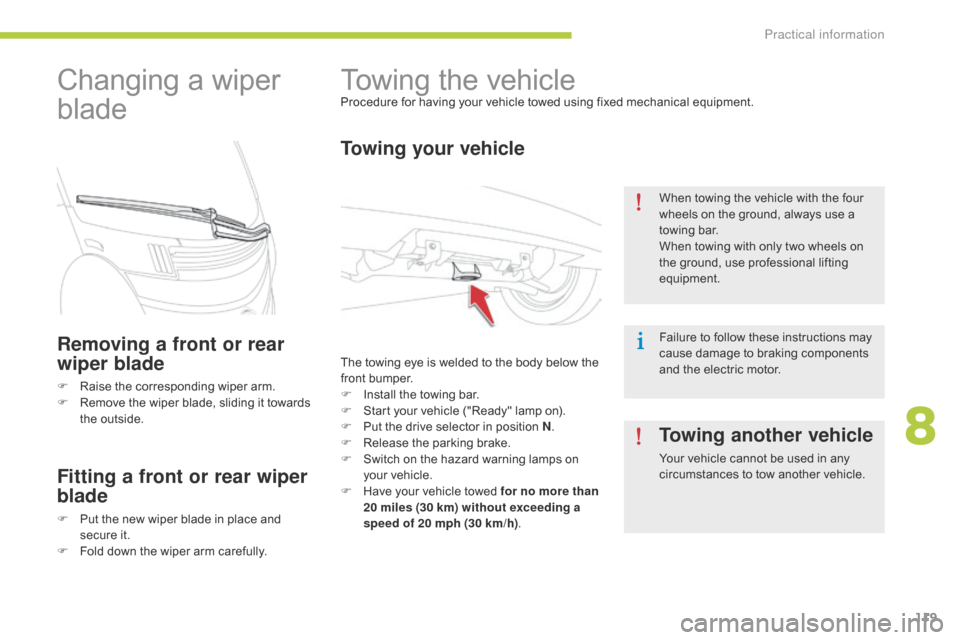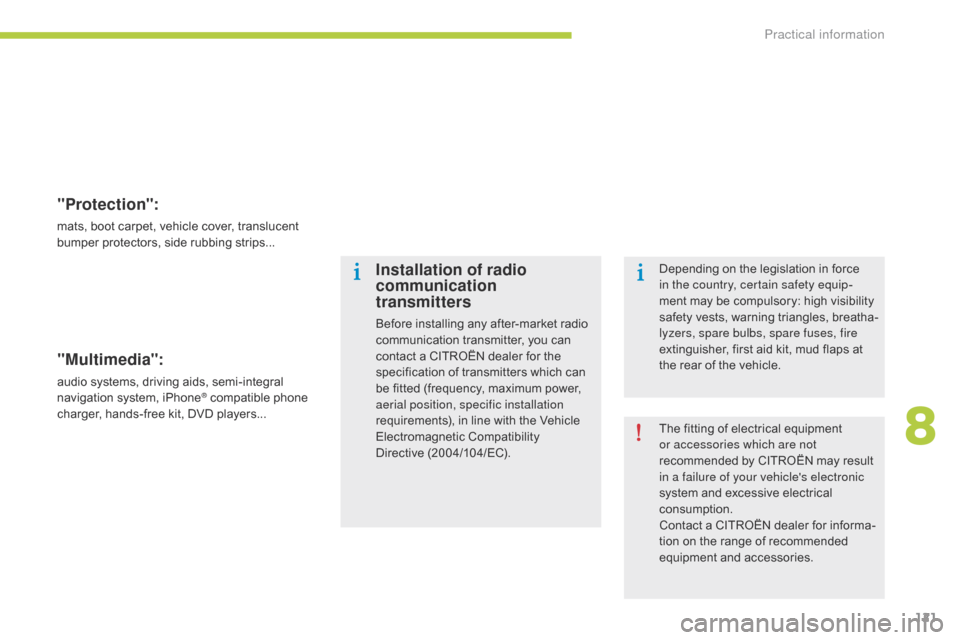Citroen C ZERO 2015 1.G Owner's Manual
Manufacturer: CITROEN, Model Year: 2015, Model line: C ZERO, Model: Citroen C ZERO 2015 1.GPages: 176, PDF Size: 5.21 MB
Page 121 of 176

119
C-zero_en_Chap08_info-pratiques_ed01-2014
Towing the vehicleProcedure for having your vehicle towed using fixed mechanical equipment.
Towing your vehicle
The towing eye is welded to the body below the
front bumper.
F
In
stall the towing bar.
F
St
art your vehicle ("Ready" lamp on).
F
Pu
t the drive selector in position N .
F
Re
lease the parking brake.
F
Sw
itch on the hazard warning lamps on
your vehicle.
F
Ha
ve your vehicle towed for no more than
20 miles (30 km) without exceeding a
speed of 20 mph (30 km/h) .When towing the vehicle with the four
wheels on the ground, always use a
towing bar.
When towing with only two wheels on
the ground, use professional lifting
equipment.
Failure to follow these instructions may
cause damage to braking components
and the electric motor.
Changing a wiper
blade
Removing a front or rear
wiper blade
F Raise the corresponding wiper arm.
F Re move the wiper blade, sliding it towards
the outside.
Fitting a front or rear wiper
blade
F Put the new wiper blade in place and
s ecure it.
F
Fo
ld down the wiper arm carefully.
Towing another vehicle
Your vehicle cannot be used in any
circumstances to tow another vehicle.
8
Practical information
Page 122 of 176

120
C-zero_en_Chap08_info-pratiques_ed01-2014
accessories
A wide range of accessories and genuine parts is available from the CITROËN dealer network.
These accessories and parts are all suitable for your vehicle and benefit from CITROËN's
recommendation and warranty.
Conversion kits
You can obtain an "Enterprise" kit to convert a
trade vehicle to a private car and vice-versa.
"Comfort":
black armrest, reading lamp, insulated
modules, rear parking sensors, cigarette
lighter, ashtray with base, head restraint
mounted coat hanger...
"Transport solutions":
boot liner, boot carpet, rear parcel shelf, boot
dividers...
"Security and safety":
alarm, wheel security bolts, child seats,
breathalyzer, warning triangle, high visibility
vest, first aid kit, snow chains, non-slip covers,
pet transport cage, pet safety belt...
Precautions for
washing
To avoid damaging the electrical
components, the use of a high pressure
jet wash is strictly prohibited:
-
in t
he front compartment (under the
bonnet),
-
un
der the body.
For washing the body, do not use a
pressure greater than 80
b
ars.
Check - before washing the vehicle -
that the charging flaps and the charging
socket covers (normal and fast charge)
are properly closed.
do no
t wash the vehicle while the
battery is being recharged.
Practical information
Page 123 of 176

121
C-zero_en_Chap08_info-pratiques_ed01-2014
"Protection":
mats, boot carpet, vehicle cover, translucent
bumper protectors, side rubbing strips...
"Multimedia":
audio systems, driving aids, semi-integral
navigation system, iPhone® compatible phone
charger, hands-free kit, DVD players...
Installation of radio
communication
transmitters
Before installing any after-market radio
communication transmitter, you can
contact a CITROËN dealer for the
specification of transmitters which can
be fitted (frequency, maximum power,
aerial position, specific installation
requirements), in line with the Vehicle
Electromagnetic Compatibility
Directive
(
2004/104/EC). The fitting of electrical equipment
or accessories which are not
recommended by CITROËN may result
in a failure of your vehicle's electronic
system and excessive electrical
consumption.
Contact a CITROËN dealer for informa-
tion on the range of recommended
equipment and accessories. Depending on the legislation in force
in the country, certain safety equip
-
ment may be compulsory: high visibility
safety vests, warning triangles, breatha-
lyzers, spare bulbs, spare fuses, fire
extinguisher, first aid kit, mud flaps at
the rear of the vehicle.
8
Practical information
Page 124 of 176

122
C-zero_en_Chap09_verifications_ed01-2014
TOTAL & CITROËN
TOTAL and CITROËN personnel combine their
talents to optimise the efficient use of energy and
reduce the impact on the environment.
The partnership between our two groups, which is
on an international scale, does not merely amount
to the supply and maintenance of vehicles to the
public: our positions as industrial leaders allow us
to meet the environmental challenges of today and
of tomorrow.
To provide ecologically responsible mobility to
everyone is more than our motor, it is our passion.
Innovation is on the way, the future of the
automobile depends on it; we will meet it
t o g e t h e r.
prefers
PARTNERS IN THE FUTURE
OF THE AUTOMOBILE
Checks
Page 125 of 176

123
C-zero_en_Chap09_verifications_ed01-2014
bonnetProtects the components in the front compartment and provides access for checking levels, charging the 12 V ancillaries battery, changing fuses, ...
F
Pu
sh the exterior safety catch B to the left
and raise the bonnet. F
Op
en the bonnet fully and on the right,
unclip the stay C from its holder.
F
Fi
t the stay C in one of the two notches to
hold the bonnet open.
F
Op
en the front right door.
F
Pu
ll the interior release lever A , located at
the bottom of the door aperture.
Opening Closing
F Take the stay out of the support notch.
F Cl ip the stay in its housing.
F
Lo
wer the bonnet and release it at the end
of its travel.
F
Pu
ll on the bonnet to check that it is fully
latched.
Do not press down on the middle of
the bonnet if it does not fully close, as
there is a risk of deforming it. Open the
bonnet fully and close it again.
The location of the interior release lever
prevents opening of the bonnet while
the front right door is closed.
9
Checks
Page 126 of 176

124
C-zero_en_Chap09_verifications_ed01-2014
1. Screenwash fluid reservoir.
2. He ater fluid reservoir.
3.
Br
ake fluid reservoir.
4.
Anc
illaries battery.
5.
Fus
ebox.
Front compartment
To avoid damaging electrical
components, the use of a high pressure
jet washer in the front compartment is
strictly prohibited.
Checks
Page 127 of 176

125
C-zero_en_Chap09_verifications_ed01-2014
Rear compartmentLocated under the boot floor, this compartment gives access to the cooling system reservoir.
F
Op
en the boot.
F
De
tach the carpet retaining adhesive strip.
F
Re
move the boot carpet. F
Re
move the four "butter fly" screws.
F
Re
move the protective cover.F
Ch
eck the coolant level and top up if
necessary (see following pages).
When working in this compartment,
you must observe the safety
recommendations on the labels.
9
C
Page 128 of 176

126
C-zero_en_Chap09_verifications_ed01-2014
Checking levelsCheck all of these levels regularly and top them up if necessary, unless other wise indicated.
If a level drops significantly, have the corresponding system checked by a CITROËN dealer or a qualified workshop.Never do anything in the compartments
when the "Ready" lamp is on or when
your vehicle is being charged.
Take care when carrying out checks
in the front and rear compartments as
some parts of the compartments can
be very hot (risk of burns): wait at least
one hour after stopping the motor or the
end of the charging procedure before
carrying out any work.
Brake fluid level
The brake fluid level should be
between the "MIN" and "MA X"
marks. If it is not, check the brake
pad wear.
Changing the fluid
Refer to the manufacturer's service schedule
for details of the interval for this operation.
Fluid specification
The brake fluid must conform to the
manufacturer's recommendations.
Front compartment Heating system fluid level
Changing the fluid
The fluid does not have to be changed.
Fluid specification
The fluid must conform to the manufacturer's
recommendations. The level of this fluid should be between the "L"
MIN and "F" MA X marks.
Screenwash fluid level
Top up the level when necessary.
Fluid specification
For optimum cleaning and to avoid freezing,
this fluid must not be topped up or replaced
with plain water.
Checks
Page 129 of 176

127
C-zero_en_Chap09_verifications_ed01-2014
The coolant level should be between
the MIN "L" and MA X "F" marks.
Coolant levelAvoid prolonged contact of used fluids
with the skin.
Most of these fluids are harmful to
health and some are very corrosive.
Do not discard used fluids into sewers
or onto the ground.
Take used fluids to a CITROËN dealer
or a qualified workshop (France) or to
an authorised waste disposal site.
Used products
Rear compartment
Changing the coolant
The coolant does not have to be changed.
Coolant specification
The coolant must conform to the
manufacturer's recommendations. As the cooling system is pressurised, wait at
least one hour after switching off the motor
and/or the end of the charge cycle before
carrying out any work.
To avoid any risk of scalding, unscrew the cap
by two turns to allow the pressure to drop.
When the pressure has dropped, remove the
cap and top up the level.
Ancillaries battery
electrolyte level
Remove the battery protective cover to check
this level (refer to the"ancillaries battery"
section).
The electrolyte level should be between the
MIN "LOWER LEVEL" and MA X "UPPER
L E V E L" .
If necessary, top up using distilled water by
removing the individual battery caps.
Check the electrolyte level at least once
per month.
9
Checks
Page 130 of 176

128
C-zero_en_Chap09_verifications_ed01-2014
ChecksUnless other wise indicated, check these components in accordance with the manufacturer's service schedule.
Other wise, have them checked by a CITROËN dealer or a qualified workshop.
Passenger compartment filter
Refer to the manufacturer's
service schedule for details of the
replacement intervals for this filter.
Brake wear depends on the style
of driving, particularly in the case
of vehicles used in town, over short
distances. It may be necessary to have
the condition of the brakes checked,
even between vehicle services.
Brake pads
Only use products recommended by
CITROËN or products of equivalent
quality and specifications.
In order to optimise the operation
of units as important as the braking
system, CITROËN selects and offers
very specific products.
Parking brake
If a loss of effectiveness of this
system is noticed, the parking brake
must be checked, even between
two
s
ervices.
Brake disc / drum wear
For information on checking the
brake disc or drum wear, contact
a CITROËN dealer or a qualified
workshop.
This system must be checked by a CITROËN
dealer or a qualified workshop.
Depending on the environment (e.g. dusty
atmosphere) and the use of the vehicle
(e.g.
c
ity driving), replace it twice as often
if necessary .
A dirty passenger compartment filter may have
an adverse effect on the per formance of the air
conditioning system and generate undesirable
odours.
Unless there is a leak in the circuit, a drop in
the brake fluid level indicates that the brake
pads are worn.
Checks